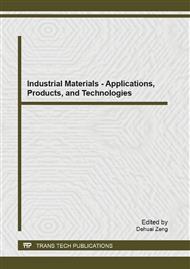[1]
S. Adamczak-W. Makiela et all., Statistical validation of the method for measuring radius variations of components on the machine tool In: Metrology and Measuring Systems Vol. 18, no. 1, pp.35-46, ISSN: 0860-8229, (2011).
DOI: 10.2478/v10178-011-0004-5
Google Scholar
[2]
L. Belluco-L. De Chiffre, Evaluation of vegetable-based oils in drilling austenitic stainless steels. Journal of Materials Processing Technology 148, pp.171-176, (2004).
DOI: 10.1016/s0924-0136(03)00679-4
Google Scholar
[3]
M. Čillikova-J. Salaj-A. Mičietova-J. Pilc, Influence of Cutting Fluids on Cutting Forces when Grinding Bearing Steel, Journal of Machine Manufacturing Design and Manufacturing, The Scientific Society for Mechanical Engineering, Hungary, Volume XLIX. Issue E3-E5, INDEX: 25344 HU ISSN 0016-8580, pp.101-103, (2009).
Google Scholar
[4]
T. Fujiwara, T. Kato, S. Abeyama, S. Nakamura, Effects of Free-Machining Additives on Machinability of the 18Cr-2Mo Stainless Steel. Proceedings of the International Symposium on Influence of Metallurgy on Machinability of Steel, 26. -28. September, Tokyo, pp.231-240, (1977).
Google Scholar
[5]
J. Gašparová-J. Šugárová-D. Kalincová, Study of microstructure and formed part wall thicness changes after metal spinning. In Development of mechanical engineering as a tool for the enterprise logistics progress : science report : project CII-PL-0033-01-0506, Poznan University of Technology, ISBN 83-89873-28-1, pp.187-192, (2006).
Google Scholar
[6]
S. Hrehová-A. Vagaská, Application of fuzzy principles in evaluating quality of manufacturing process. In: WSEAS Transaction on Power Systems. 7, 2, pp.50-59, ISSN 1790-5060, (2012).
Google Scholar
[7]
H. Chandrasekaran, J. Johansson, Chip Flow and Notch Wear Mechanisms during the Machining of High Austenitic Stainless Steels. Annals of the CIRP 43, 1, pp.101-105, (1994).
DOI: 10.1016/s0007-8506(07)62174-x
Google Scholar
[8]
I. Leššo-P. Flegner-M. Šujanský-E. Špak, Research of the possibility of application of vector quantisation method for effective process control of rocks disintegration by rotary drilling. In: Metalurgija 1, Vol. 49, pp.61-65, ISSN 0543-5846. (2010).
Google Scholar
[9]
W. Makiela-J. Zajac, An evaluation of irregularities of milled surfaces by the wavelet analysis, ICAEEI, Venice, Italy, September 7-10, 2010, pp.63-69, ISBN 978-80-553-0519-6, (2010).
Google Scholar
[10]
M. Neslušan-I. Mrkvica-R. Čep-D. Kozak-R. Konderla, Deformation After Heat Treatment and Their Influence on Cutting Process. Tehnički vjesnik/Technical Gazette, 2011, Vol. 18, No. 4, pp.601-608 . ISSN 1330-3651(2011).
Google Scholar
[11]
I. Pandová-T. Gondová-K, Dubayová, Natural and modified clinoptilolite testing for reduction of harmful substance in manufacturing exploitation. Advanced Materials Research, Vol. 518-523, pp.1757-1760, ISSN 1022-6680. (2012).
DOI: 10.4028/www.scientific.net/amr.518-523.1757
Google Scholar
[12]
D. Peckner I.M. Bernstein, Handbook of Stainless Steels. New York: McGraw-Hill, (1977).
Google Scholar
[13]
J. Peterka-P. Pokorný-Š. Václav, CAM strategies and surfaces accuracy. In: Annals of DAAAM and Proceedings of DAAAM Symposium. ISSN 1726-9679, 19, 1. pp.1061-1062 (2008).
Google Scholar
[14]
T. Zaborowski, Ekowytwarzanie. Gorzow, p.100, (2007).
Google Scholar
[15]
M. Žitňanský-J. Zrník-M. Martinkovič, Developing processes of property improvement of nickel base superalloys. In: Journal of Materials Processing Technology. - ISSN 0924-0136, 78, pp.204-209, (1998).
DOI: 10.1016/s0924-0136(97)00484-6
Google Scholar


